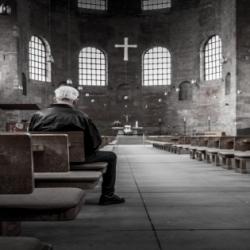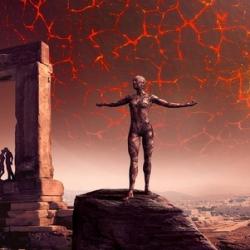
Stuff can get lost in the packing process. In my case, it was a favorite pair of sandals that somehow got left behind as we packed up for the final time on our month-long vacation that was almost my trip to the graveyard. One of the souvenirs I brought back was Legionnaires’ disease, which lead to multiple strokes on both sides of my brain, failing organs, and a six-week coma. Talk about package deals.
I SPENT A MONTH IN SICILY AND ALL I GOT WAS THIS LOUSY NEAR-DEATH EXPERIENCE.
Unpacking can be hazardous too. Objects can be uncovered that were never in the visitor’s luggage in the first place. This isn’t my red suitcase! And when the travelers have to report the lost contents, the details suddenly become hazy. Did we pick up that little bust of Mussolini cast with Mt. Etna lava, or not? Other times, objects can wind up broken, and when they’re reassembled, look nothing like the original. I think something similar to the last two happened with Eben Alexander’s unpacked “memories” of his near-death experience (NDE).
Some skeptics have long dismissed NDEs as hallucinations or products of the experiencer’s imagination, dreamed up after their brush with death. This view was triumphantly expressed by prominent skeptic and clinical neurologist Steven Novella in a 2014 blog post about a study that tried (and failed) to prove out-of-body experiences during NDEs were real by placing hidden targets above the operating room. Shockingly, not one experiencer reported seeing the targets. But other skeptics, such as psychologist Susan Blackmore, as well as neurologist Kevin Nelson, have studied NDEs extensively, examining them from a neurobiological perspective and concluding that NDEs are real. Not that NDEs represent actual day trips to Heaven, of course, but that they’re a real neurological phenomenon. I detailed Professor Nelson’s REM intrusion theory in my Skeptical Inquirer article “Covert Cognition: My So-Called Near-Death Experience” because I neatly fit into the population shown by his study to be most likely to have an NDE: people who are prone to forms of REM intrusion like my lucid dreaming. I even engaged in lucid dreaming within my NDE.
In her book Dying to Live and in a Skeptical Inquirer article, Susan Blackmore persuasively argues that imagination or hallucinations alone can’t account for the underlying similarities among many NDEs. I believe that there is indeed a role for later imagination in explaining elements of NDEs, but that’s often related to retrospectively interpreting the experience and its meaning, the process that Eben Alexander refers to as unpacking his NDE.
Though he says he didn’t read about NDEs until after he wrote he experience down, I can’t help wondering how much of his story was later interpreted in ways that conformed to his subsequent research. He refers to seeing flocks of orbs—shimmering beings with streamers trailing behind them—as angels. He calls the God-orb Om due to the New Agey sound it emitted. He believes this was God not because of any “I am the Lord God” pronouncements, but due to the feeling he experienced in its presence. The Girl on the Butterfly Wing, as Alexander calls her (as referred to in Near-Death is But a Coma-Dream), is belatedly identified as the late sister he never met. So, he recognized her immediately after he received a photo of the sister, right? Nope. He only decided she was the butterfly-rider after he read the story of a young girl telling her parents that she had been comforted by an older brother during her NDE, even though she didn’t know that she actually had a brother who died before she was born. Cue the theremin music. (You think maybe she had overheard her parents discussing the dead brother? Or maybe she always wanted an older brother?) One wonders whether the image of the woman in his mind, many months after his NDE, might have morphed into the one in the picture of his dead sister. Memory is not like Memorex. It’s more like Play-Doh.
Soon before Alexander’s awakening, the crude Realm of the Earthworm’s-Eye View section of his NDE (which I wrote about in my last post) suddenly became more detailed. Instead of vague animal faces bubbling up from the murk, he heard prayers and saw recognizable faces. Not coincidentally, most of the faces belonged to the people praying around his bedside the night before and the day of his awakening. All but one, that is. And here’s where Alexander not only damages his claim of skepticism prior to his NDE, but also shows that he’s been engaging in unconscious mental editing.
His wife Holley apparently has an uncommon number of friends who believe they have psychic abilities. Yes, just as believers and nonbelievers can have perfectly happy marriages, so can skeptics and believers in psychic phenomena. Still, it makes me wonder how firm a skeptic Alexander really was. At any rate, one of Holley’s “psychic” friends, Susan Reintjes, is a channeller who claims to contact coma patients. So Holley asks Susan to contact Eben. Later he says that Susan was among the faces he saw, even though she was never in his hospital room. Wooooo.
Proof of Heaven?
You’ll be shocked to hear that I have a different interpretation, as someone who knew she had a trach and was on a ventilator just from overhearing conversation around her (though I didn’t know I was in a coma). Perhaps Eben overheard Holley mentioning that Susan was going to try and contact him? Nah.
And finally, we come to those great secrets of the universe Alexander claims to be unpacking. I haven’t read Alexander’s two sequels, but in Proof of Heaven all the unpacked “wisdom” he received could fit in a fortune cookie. That would certainly save on overweight luggage fees. Apparently, God is love, and love really does make the world go around. That’s it. And for that God nearly killed him so he could bring that message back? Alexander implies that it was no coincidence that a neurosurgeon came down with an extremely rare adult case of E. Coli meningitis. He’s God’s chosen messenger to the scientific community. What, an email wouldn’t have worked?
For all that, and his newly professed Christianity (though he didn’t actually have a meetup with Jesus), Alexander’s message is awfully New Age. The book is also filled with the sorts of pseudoscientific claptrap about quantum mechanics and its supposed relationship with the spiritual realm that would set Deepak Chopra’s heart aflutter. To me, these sections show the strongest signals of retrospective interpretation. The end matter to Proof of Heaven is filled with acknowledgements to NDE groups and researchers and flakey New Age institutes like the Monroe Institute, for which extols the virtues of Hemi-Sync sleep learning “technology.” Coincidence?
If Alexander was indeed once a skeptic, he is no longer. He now believes in remote viewing, psychokinesis, precognition, and clairvoyance. Really? What does seeing Heaven have to do with that load of woo? It would take the kind of profound brain damage my doctors thought I had for me to believe in that bullshit.
The irony is that many skeptics have dismissed NDEs because they believe it requires mind-brain separation (as I once did), much as NDE true-believers have always maintained. But I believe covert cognition is the missing piece of the puzzle. If the brains of experiencers are still active on a presently undetectable level (though that’s changing), then the argument for mind-brain separation evaporates. In Proof of Heaven, Alexander repeatedly proclaims his intention to convince the scientific community of the validity of NDEs. But in the process, as he continues to insist on his unsupportable claim that his brain had ceased functioning during his NDE, he denies one of the best lines of evidence that NDE are more than after-the-fact fantasies.














